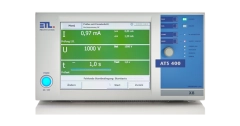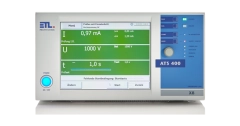Leakage Current Test
WHAT IS A LEAKAGE CURRENT TEST?
A leakage current test is a procedure for testing the leakage current of an electrical device or system. The leakage current is the current that flows through unwanted paths, such as through the insulation or via the protective earth conductor. The leakage current test measures the current that flows through these unwanted paths to ensure that it is within safe limits. A high leakage current measurement can indicate faulty insulation or other problems that can lead to an increased risk of electric shock. Proper leakage current testing is important to ensure the safety of people using the electrical device and to ensure that it complies with applicable safety standards.
HOW IS A LEAKAGE CURRENT MEASUREMENT CARRIED OUT?
Here are the basic steps for carrying out a leakage current measurement:
- Standards: Analysis of which standard and which specified diagrams must be used for testing.
- Preparation: Make sure that the device is switched off and disconnected from the power supply. Also check that the tester is working properly and is calibrated.
- Connecting the test device: Connect the test device to the device connections to be tested. Ensure that the connection is firm and secure.
- Setting the test voltage / test current: Set the desired test voltage and the maximum test current on the test device. The test voltage / test current depends on the specific requirements of the device or the standard to be tested.
- Carry out the test: Switch on the test device and start the leakage current test.
- Evaluation of the result: The measurement results are given in amperes. There are various standards and regulations that specify the maximum values for the leakage current that must be adhered to in order to ensure safety.
The leakage current measurement is an active test in which the test object is tested when it is switched on.
-
 ATS400 UHGIPFA-5030L30L32Article number 212313
ATS400 UHGIPFA-5030L30L32Article number 212313- HV AC - High Voltage Testing
100,0 - 5000 V AC, 0,01 - 100,00 mA (opt. from 1 nA), potential free, ramp, discharge monitoring - HV DC - High Voltage Testing
50,0 - 3000 V DC, 0,01 - 2,00 mA, current limited, potential free, active discharge, ramp, discharge monitoring - ISO - Insulation Testing
50,0 - 3000 V DC, 500,0 kΩ - 1000 MΩ (opt. 5 GΩ), current limited accor. EN 50191, earthed on one side, active discharge, ramp, discharge monitoring - PE - Testing of Protective Earth
2,0 - 32,0 A AC/DC (opt. up to 40 A), 1 - 500 mΩ - FCT Mains - Function Measurement
Mains Voltage, 10,00 A (opt. 16,00 A) - FCT variable - Function Measurement
1,0 - 270,0 V AC, 45- 65 Hz, 500 VA, electronic source - AI - Leakage Current Testing
0,1 µA - 30,00 mA, 0 - 1 MHz, EN 60601-1 (medical), EN 60990-1 (industrial), opt. other standards - Contacting options
CCCG
- HV AC - High Voltage Testing
-
 ATS400 UHGIPFA-507030L32Article number 212200
ATS400 UHGIPFA-507030L32Article number 212200- HV AC - High Voltage Testing
100,0 - 5000 V AC, 0,01 - 100,00 mA (opt. from 1 nA), potential free, ramp, discharge monitoring - HV DC - High Voltage Testing
150,0 - 7000 V DC, 0,01 - 100,00 mA (opt. from 1 nA), max. 500VA, potential free, active discharge, ramp, discharge monitoring - ISO - Insulation Testing
50,0 - 3000 V DC, 500,0 kΩ - 400,0 MΩ (opt. 5 GΩ), current limited accor. EN 50191, earthed on one side, active discharge, ramp, discharge monitoring - PE - Testing of Protective Earth
2,0 - 32,0 A AC/DC (opt. up to 40 A), 1 - 500 mΩ, 4 - wire measurement - FCT Mains - Function Measurement
Mains Voltage, 10,00 A (opt. 16,00 A) - FCT variable - Function Measurement
1,0 - 270,0 V AC, 45- 65 Hz, 500 VA, electronic source - AI - Leakage Current Testing
0,1 µA - 30,00 mA, 0 - 1 MHz, EN 60601-1 (medical), EN 60990-1 (industrial), opt. other standards - Contacting options
CCCG
- HV AC - High Voltage Testing
-
 ATS400 UHGIPRFA-507030L32Article number 212183
ATS400 UHGIPRFA-507030L32Article number 212183- HV AC - High Voltage Testing
100,0 - 5000 V AC, 0,01 - 100,00 mA (opt. from 1 nA), potential free, ramp, discharge monitoring - HV DC - High Voltage Testing
150,0 - 7000 V DC, 0,10 - 100 mA, potential free, active discharge, ramp, discharge monitoring - ISO - Insulation Testing
50,0 - 3000 V DC, 500,0 kΩ - 400,0 MΩ (opt. 5 GΩ), current limited accor. EN 50191, earthed on one side, active discharge, ramp, discharge monitoring - PE - Testing of Protective Earth
2,0 - 32,0 A AC/DC (opt. up to 40 A), 1 - 500 mΩ, < 12 V - R - Resistance Measurement DC4
1 µA - 2 A, 0,01 µΩ - 2,2000 MΩ, 4-wire measuring technique, contact monitoring, automatic measuring range selection, optional 11 fixed measuring ranges - FCT variable - Function Measurement
1,0 - 270,0 V AC, 45- 65 Hz, 500 VA, electronic source - AI - Leakage Current Testing
0,1 µA - 30,00 mA, 0 - 1 MHz, EN 60601-1 (medical), EN 60990-1 (industrial), opt. other standards - Contacting options
CCCG
- HV AC - High Voltage Testing
-
 ATS400 AI-AC1-IMArticle number 201958
ATS400 AI-AC1-IMArticle number 201958- FCT variable - Function Measurement
1,0 - 270,0 V AC, 45- 65 Hz, 500 VA, electronic source - AI - Leakage Current Testing
0,1 µA - 30,00 mA, 0 - 1 MHz, EN 60601-1 (medical), EN 60990-1 (industrial), opt. other standards - Contacting options
CCCG
- FCT variable - Function Measurement
Basics of leakage current testing
As a leading provider of electrical safety testing, we place great emphasis on leakage current testing. This testing is crucial to ensure that electrical equipment and systems meet safety standards and do not cause dangerous leakage currents. Leakage currents are unwanted electrical currents that can flow into non-conductive parts of the equipment or system, potentially dangerous to users and the environment.
The leakage current test is carried out according to strict norms and standards such as DIN VDE 0701-0702. It involves measuring the currents that can pass from conductive parts to touchable, non-conductive parts. These measurements help to ensure that the leakage currents are within safe limits. At ETL Prüftechnik we use the latest testing equipment to guarantee accurate and reliable results. Our experts ensure that your devices and systems meet the highest safety requirements and thus help to prevent electrical accidents.
Benefits of leakage current testing for companies
At ETL Prüftechnik we offer comprehensive leakage current tests that bring numerous benefits to companies. Regular leakage current tests make a decisive contribution to the safety and efficiency of your electrical systems and equipment. One of the most important benefits is the minimization of downtime. By detecting and correcting errors at an early stage, potential malfunctions and costly repairs can be avoided. This ensures smooth operations and protects your investment.
Another significant benefit is the increase in operational safety. Leakage currents can lead to dangerous situations that endanger the life and health of your employees. Through regular testing, we ensure that your systems meet safety standards and that risks are minimized. In addition, leakage current testing helps to meet legal requirements and regulations, which is essential for the legal protection of your company.
Compliance with insurance requirements is another advantage. Many insurance companies require regular safety tests, including leakage current testing, to ensure full coverage in the event of damage. With the professional services of ETL Prüftechnik, you are on the safe side and can rest assured that all requirements are met. Trust in our expertise to maximize your operational safety and save costs in the long term.
Common errors that can be avoided by leakage current testing
Common faults that can be avoided by leakage current testing include inadequate insulation, defective components and faulty wiring.
A common fault is inadequate insulation of cables and components. Wear, aging or mechanical damage can impair the insulation, causing unwanted leakage currents. These currents can flow into accessible parts of the device and pose a significant safety risk. Regular leakage current tests enable us to identify these weak points and take early action to remedy them.
Defective components are another common source of errors. Electronic components that have been damaged by overload, moisture or temperature fluctuations can also lead to increased leakage currents. The leakage current test from ETL Prüftechnik reliably detects such defects. Our high-precision testing devices make it possible to detect even the smallest deviations, so that defective components can be replaced in good time before they cause greater damage.
Faulty wiring is also a common problem that leakage current testing can uncover. Improper installations, loose connections or incorrect wiring can result in dangerous leakage currents. Our tests ensure that wiring is correct and safe. This is especially important in complex electrical systems where small errors can have a big impact.
With ETL Prüftechnik's leakage current testing, companies can avoid these common mistakes and ensure the safety of their electrical systems. Our regular tests not only help to identify potential hazards, but also extend the lifespan and reliability of your equipment
Buying leakage current testers – What you should pay attention to
When you purchase leakage current testers from us, you gain access to a wide range of state-of-the-art devices that meet all relevant standards such as DIN VDE 0701-0702. Our devices are designed to deliver precise and reliable measurement results to ensure the safety of your electrical systems. Take advantage of our free and detailed advice to ensure that you find the right device for your specific testing requirements. Rely on our experience and our commitment to the highest quality and safety.

